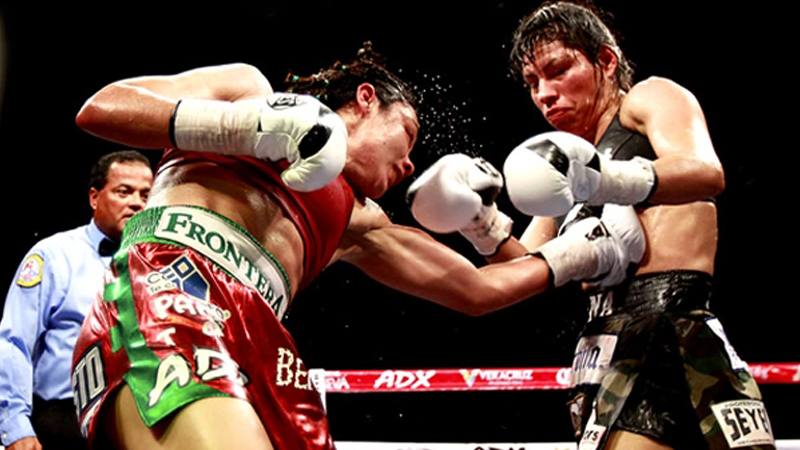
2 minutes versus 3 minutes round in professional women boxing-does it matter?
Nitin K Sethi,MD and Jennifer Galjour,MD
DISCLOSURES: NKS serves as Chief Medical Officer of the New York State Athletic Commission. JG serves as ringside physician for the New York State Athletic Commission. The views expressed by the authors are their own.
Currently in most commission jurisdictions in the United States, professional woman boxing consists of 2-minute rounds. Some commissions such as the New York State Athletic Commission (NYSAC) allow 3-minute rounds provided both combatants agree to this format. If either of the two combatants wishes to fight 2-minute rounds, the fight is scheduled as such. Should professional women boxers fight 3-minute rounds versus 2-minute rounds, akin to their male counterparts, has recently been debated in the combat sports media and online on social media networks such as Twitter and Facebook. The argument advanced for fighting 3-minute rounds is that this would level the playing field between men and women professional boxers. 3-minute rounds will make women boxing more exciting to watch and hence more marketable to the fans. Women boxers can then advocate for equal pay for equal work as their male counterparts. This argument for 3-minute rounds based on gender and pay equality is countered by entities in favor of 2-minute rounds in women boxing by voicing concern that women boxers are more prone to concussions as compared to their male counterparts. Hence extending round duration to 3-minutes risks their health and safety.
So, does it matter if in professional women boxing rounds are 3-minutes versus 2-minutes? If one were to debate this question on pure medical grounds, the answer is a resounding yes. While scientific data with respect to combat sports is lacking, gender and sex differences in concussion incidence and outcome has been studied and showed a woman’s brain more susceptibility to concussive injuries as compared to a male brain. Similarly, children are more susceptible to concussions than adults. Mollayeva et al. reviewed these gender and sex differences in concussion in an article published in the journal Concussion. ‘ The increased susceptibility and vulnerability to concussion in women as compared to men is thought to be due to disparities in neck musculature and head to neck stability which likely lowers concussion biomechanical threshold. Hormonal factors such as estrogens may also make women more vulnerable to concussion and influence recovery time after a concussive injury. In athletes of the National Collegiate Athletic Association, Covassin et al. reported a 1.4 times greater incidence of concussions in females as compared to males in sex-comparable sports such as basketball and soccer. 2 Since objective measures of concussion are still not available, most studies used subjective self-reported measures and the influence of social factors (more socially acceptable for women to report physical vulnerability as compared to men) remains unclear.
Combat sports such as boxing are unique since every punch thrown at the head is thrown with the intention of winning by causing a knockout (aka a concussion). While boxing has many beneficial effects on the cardiovascular system, one cannot defend boxing by saying it is good for the brain. There is an exceedingly high risk for both acute and chronic neurological injuries. Acute neurological injuries may occur during the course of the bout or present soon after the bout is over and include subdural hematoma (SDH), epidural hematoma (EDH), subarachnoid hemorrhage (SAH), intracranial hematoma and injury to the great vessels of the neck such as carotid or vertebral artery dissection. Chronic neurological injuries include chronic traumatic encephalopathy (CTE), dementia pugilistica (DP), chronic posttraumatic headaches, chronic posttraumatic dizziness, chronic posttraumatic cognitive deficits, and chronic posttraumatic Parkinsonism. Since chronic neurological injuries present long after the boxer’s career is over, it is inherently difficult to protect a fighter from these devastating injuries. No amount of boxing is good for the brain-not one round, not 40. Some studies on boxershave suggested that boxers with long professional careers are the ones most susceptible to the above mentioned chronic neurological injuries. One does not need a neurologist to opine that limiting round duration to 2-minutes protects the boxer’s neurological health with respect to both acute as well chronic neurological injuries associated with boxing.
Limiting the number of total rounds in a bout and the duration of each round protects the neurological
health of the fighter irrespective of sex.
Gender and pay inequality are important social issues which the boxing community cannot turn its back to. These important issues are not unique to professional woman boxing and it is important to understand how these issues adversely affect the growth of woman boxing and discourage many promising women boxers from pursuing a career in professional boxing. These issues need to be addressed on an urgent basis and change needs to come from within the boxing community. The issue of 2-minutes versus 3-minute rounds in woman boxing though needs to be debated, scientifically studied and decided purely on medical grounds based on concrete evidence based medicine whether women partaking in professional boxing are more susceptible to concussions as compared to men and how the duration of the round alters their risk for both acute and chronic neurological injuries.
References
- Mollayeva T, El-Khechen-Richandi G, Colantonio A. Sex & gender considerations in concussion research. Concussion. 2018;3:CNC51.
- Covassin T, Moran R, Elbin RJ. Sex differences in reported concussion injury rates and time loss from participation: an update of the National Collegiate Athletic Association Injury Surveillance Program from 2004-2005 through 2008-2009. J.Athl. Train.2016;51:189-194.
![]()
Related posts
test


